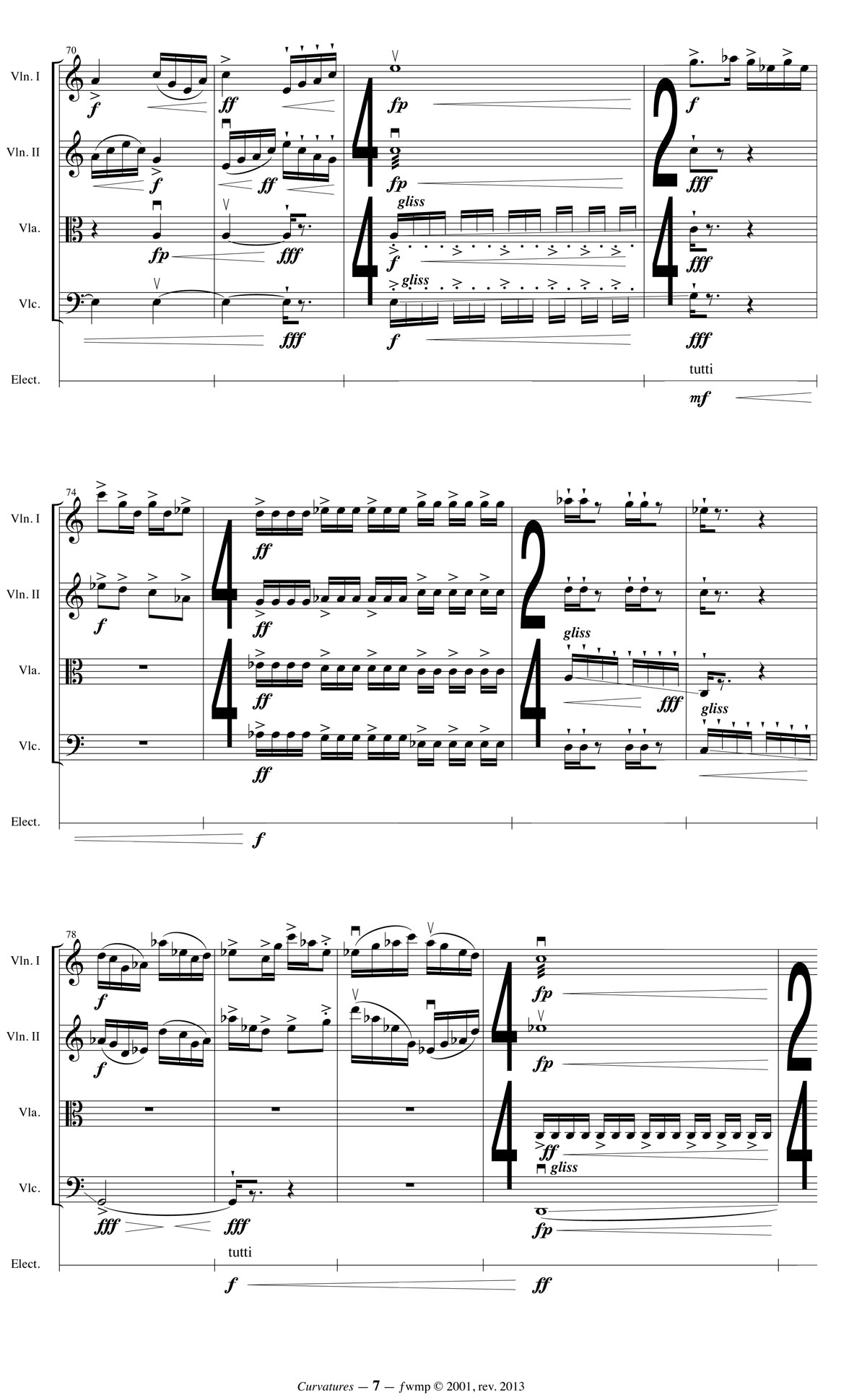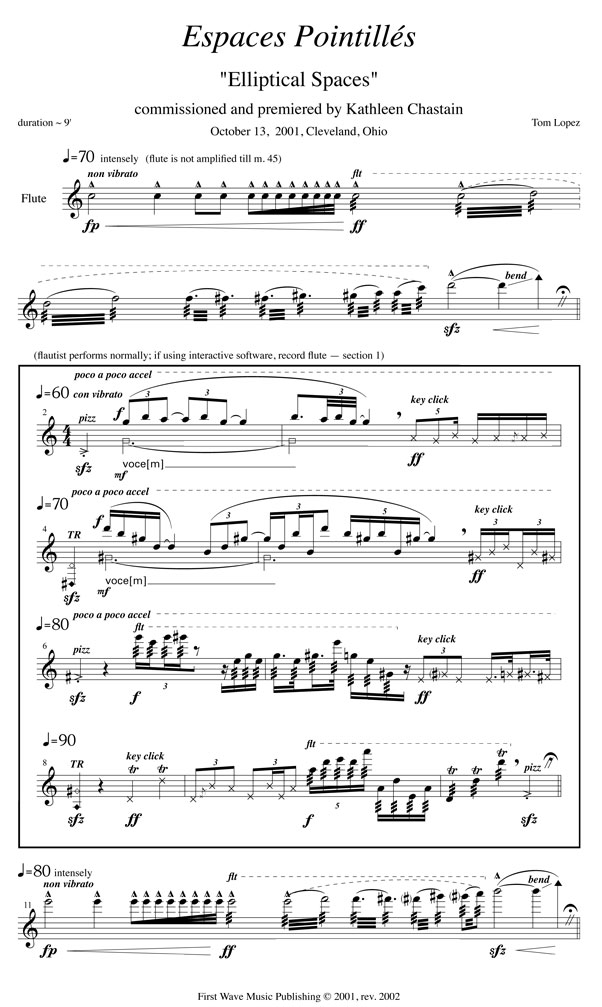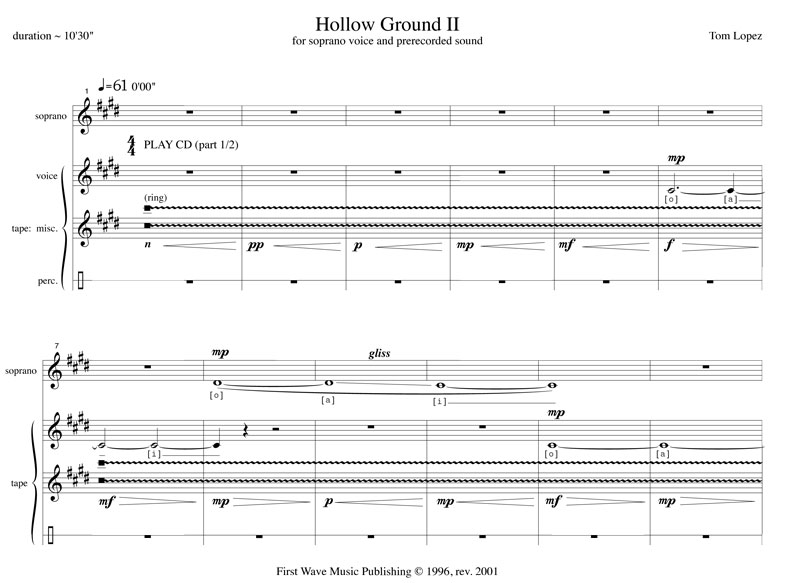

| more photos... |
sfound Objects: 3 Vertices was composed in Oberlin, Ohio (2018). This work was created in collaboration with percussionist Justin Gunter. This constrained improvisation articulates three stations with a variety of objects including bells, shakers, wooden blocks, and eating utensils.
In Common Time was inspired by Terry Riley's composition “In C.” From the time I was a young musician, I’ve enjoyed performing and listening to Terry Riley’s seminal composition. It is recognized as one of the first, if not the first, pieces of minimalist music. Performances of “In C” can have any number of performers on any instrument, who all play through the same sequence of short melodic fragments. Each player decides how many times to repeat each fragment before moving on to the next, thus creating a constantly shifting fabric of melodic interplay.
In 2014, a full fifty years after “In C” was written, I began working on a musical response. The simple premise at the core of my piece is the exploration of rhythm, as opposed to Riley’s heterophonic exploration of pitch. In my piece, a minimum of 8 percussionists on a variety of instruments play through a sequence of rhythmic fragments. The result is a constantly shifting fabric of timbre and rhythm.
I am very grateful for the dedication and commitment of Michael Rosen and the phenomenal performers of the Oberlin Percussion Group who presented the premiere of this work in 2017.
| more photos... |
Skipping Stones was composed for the Eighth Blackbird ensemble in Oberlin, Ohio (2013). The flat, smooth, rounded stone nestles in a cocked hand, still wet from the cool lake that gently laps just below your knees. What magic occurs when it ricochets, again, and again, sending small splashes into the air and ripples through the water. You track the receding gift until it suddenly disappears, dropping into the depths, to a new home. The stone's trajectory, if it continued across the lake, travels through the tree line, across the horizon, and into the sunrise, splashing and rippling through the clouds. The undulating water touches your legs, and looking down, you plunge your arm in, finding another… Special thanks to Eighth Blackbird, Tim Weiss and the CME performers for collaborating with me.
 |  |
Curvatures was composed in Oberlin, Ohio (2001, revised in Oberlin, 2013). This work was created for amplified string quartet and optional live electronics. One of my compositional goals was to traverse a wide range of sonic worlds. The music navigates between fast and slow, thick and thin, chaotic and serene, minimal and maximal, cerebral and emotional, and so on. I wanted to compose a piece that would keep listeners on their toes, present occasional surprises, and provide something for the heart and the brain. I am indebted to the original performers for their dedication and persistence in helping me develop this music: Erica Dicker, violin; Gillian Rivers, violin; Amy Cimini, viola; and Robin Reynolds, 'cello.
The original Curvatures collaboration included dance by Nusha Martynuk with paintings by Laura Ferguson and video by Carter McAdams. Follow this link for a recording of Curvatures with quartet and electronics.
Curvatures was released by SEAMUS in 2003.
Divining Rock was composed in Oberlin, Ohio (2013) and was inspired by "Rock Piece" (1979) by Pauline Oliveros. The audience brings rocks to the performance where there is also an opportunity for optional electronics. This piece has a strong ritualistic quality and can function as a great opening piece for a concert; the audience's ears will be open and ready for listening.
| more photos... |
Lament for Réjà Vu was composed in Oberlin, Ohio (2012). “Déjà vu” is the uncanny feeling that the current moment has happened before. But what is the feeling when the current moment seems as if it will happen again in the future? There is no French term for this; however, I discovered that a British author, Sir Terry Pratchett, coined “réjà vu” for just this meaning.
This piece is a lament for seeing where we are headed but feeling powerless to change direction. This is what happens when we don’t learn from our mistakes and repeat our history. This is what happens when we are reduced to wringing our hands.
Via Métro was composed in Nice, France (1994, revised in Oberlin, Ohio 2009) for David Rice, who premiered it on June 12, 1994 in Paris. The score for Via Métro is based on the first eight lines of the Paris metro system. Performers have the freedom to switch lines of music just as riders can transfer metro lines. For example, someone on the metro system who begins on line #1 at Pont de Neuilly will arrive at Ch. de Gaulle Etoile and may continue on line #1 or transfer to line #2 or line #6. Correspondingly, performers who begin playing the music associated with line #1 will reach a point in the score where they can continue with the same line of music or may switch to the music associated with line #2 or line #6. In this manner, performers make their way through the score by choosing, at each junction, which line of music to continue playing.
Though I have used part of the metro system as a structural source, Via Métro is not a programmatic work about the metro. There are various styles of music notation, including: traditional notation, written instructions, poetry, graphics, and pictures. A performance of Via Métro combines improvisation and interpretation by any number of performers on unspecified instruments. There are also recordings of the metro, which accompany the live musicians.
I would like to give special thanks to Patricia A. Nagy for allowing me to include her poem New Year's Eve in the score.
 |
The Death of the Moth was composed in Oberlin, Ohio (2003, revised in Oberlin, 2006). It was written for chamber orchestra and electronics to accompany film by Rian Brown and Hege Røyert. "Men rush to their doom like moths flying to their death in the candle-flame"—Bhagavad Gita. The moth is drawn towards light, and like Icarus, will inevitably burn its wings and fall. "The Death of the Moth" is a meditation on mankind's "falling from grace" and his out-of-balance relationship with nature. The title is from a short story by Virginia Woolf.
The Death of the Moth was released by Centaur in 2008.
 |  |
Espaces Pointillés was composed in Oberlin, Ohio (2001, revised in Oberlin, 2002). This work for flute and electro-acoustic sound was commissioned by Kathleen Chastain and premiered by her on October 13, 2001 during the AKI Festival in Cleveland, Ohio. Espaces Pointillés translates to "elliptical spaces." Kathleen and I chose the title after lengthy consideration. We were tempted to use the word "circular," but circles are perfect loops, i.e. closed circuits that systematically return to their origins. But nothing in nature exists in perfect circles; everything is oblong, elliptical, spiral, or just plain droopy. Human-made objects can be circular, but I think one of the beautiful aspects of music is that it is human-created energy which immediately escapes our grasp and returns to nature. Music literally jumps from an instrument, in the form of sound waves, and flees in all directions as quickly as possible. If we imagine music filtering through our ears, like grains of sand through our fingers, its ephemeral quality is revealed; or more figuratively, music's destiny is to escape the instrumental sandbox and return to the sonic ocean. If we watch music with our ears, where does it go? How does it get there? What path does it take?
This work is excerpted and discussed in "Theory Essentials" by Connie Mayfield.
Thicker than Water was composed in Oberlin, Ohio (2000). Scored for winds, brass, and strings, this is a three-movement work in homage to Charles Ives.
They Hearken to Echoes was composed in Austin, Texas (1997, revised in Oberlin, Ohio 2001). The title, which describes the performers literally and metaphorically, is from the writings of architect Louis Sullivan. The overall design of the piece moves from distance to closeness: with respect to the physical placement of performers; with respect to melodic, harmonic, and rhythmic material; and especially with respect to echoes. Perhaps it is a "call-response" work, where the response time gradually diminishes until the call and the response are simultaneous. Or perhaps it is a canon modeled on a drawing by M.C. Escher, in which the second voice slowly gains ground until both voices share a moment of synchronicity.
kin-askesis was composed in Austin, Texas (1997) with video by Nate Pagel.
 |
Hollow Ground II was composed in Austin, Texas (1996). Written for soprano voice and prerecorded sound, this work has been performed with dance choreographed by Yacov Sharir. As it is the second piece in the Hollow Ground trilogy commissioned by the Sharir Dance Company, it contains sonic material from its predecessor, Hollow Ground I. Both works contain various acoustic instruments floating around my apartment at the time: shakers, rattles, rain sticks, finger cymbals, computers, and so on. Hollow Ground II does not have any text; the vocalist never sings a word — her sounds are syllabic, which, when combined with her physical gestures during performance, create a strong ritualistic quality. This is music made from the materials within arm's reach. Artists often use whatever is available to express their vision; the "whatever" is local, but I believe the desire to "express" is global. Larisa Montanaro helped record this piece and performed it numerous times around the United States.
A revised version of this work, Signatures for two singers, was composed for choreographer Elesa Rosasco in 2010.
Hollow Ground II was released by SEAMUS in 1998.
Lorelei was composed in Austin, Texas (1995). The title refers to a siren, in Germanic legends, whose beautiful singing lured sailors to shipwreck. Such evocative singing is also attributed to guiding recently-departed souls to heaven. The music is in three movements. The first movement is "Pure," English for the German word, "rein." The second movement is "Heart," English for the German word, "hard." The third movement is, "Reins," an English word defining the part of the body which is the source of affection and passion. Lorie Lee Reinhard (April 1, 1970—June 29, 1987) died in a car accident on the roads of rural Ohio. The driver also died and two additional passengers were injured.
A revised version of this work, Early Morning Surface was composed for choreographer Liza Travis.
ƒollow thru was created in Nice, France (1993) with artist Nicole Richter.
Vocal Sketch #2 was composed in Valencia, California (1991). Scored for 12 soprano voices (six parts, two voices per part), this piece uses an alternative tuning system devised by the composer. The tuning utilizes a 16-tone, equal-tempered scale based on the minor 3rd subdivided into four rather than three. The text is based upon a poem, written by the composer, with all of the consonants removed leaving only vowel sounds. For this work, the composer was awarded a Grant for Young Composers by ASCAP (American Society of Composers, Authors, and Publishers).
Fracture was created in Los Angeles, California (1990) with poet Nicole Richter.